
The Lambert House is a historic house at 204 West Jackson Street in Monticello, Arkansas. The Colonial Revival house was built in 1905 to a design by noted local architect S. C. Hotchkiss. It was built for Walter Lambert, who owned one of Monticello's first grocery stores. The two-story wood-frame house is roughly rectangular in shape, with projecting gable sections and a rear ell. Its main facade is dominated by a two-story portico, whose second story has been enclosed as a sunroom. The lower portion of the portico is supported by granite columns, and the entablature is supported by Ionic columns, which are still visible despite the sunroom conversion.

The Mississippi County Courthouse is a courthouse at Poplar Street and Hale Avenue in Osceola, Arkansas, United States, one of two county seats of Mississippi County, built in 1912. It was listed on the National Register of Historic Places in 1978. The courthouse was built in the Classic Revival style by John Gainsford and anchors the Osceola town square.

The Gregg House is a historic house at 339 Gregg Street in Fayetteville, Arkansas, near the University of Arkansas campus. It was built in 1871 and listed on the National Register of Historic Places in 1974.

The Watson House is a historic house at 300 N. Cherry Street in Hamburg, Arkansas. The two story Colonial Revival brick house was built in 1918, and features verandas on its street-facing elevations. The verandas are supported by large Ionic columns that rise two full stories to support the roof, with the second floor veranda supported by cables suspended from above. The large-proportioned house is one of the most prominent buildings in Hamburg. It was designed and built by W. C. Bunn for David Watson, owner of a successful local hardware store.

The M. E. Davis House is a historic house at 200 North Knox Street in Dermott, Arkansas. The two story wood-frame house was built in 1925, and is one of the largest houses in Dermott; it is still one of only a few two story houses there. The Craftsman style house was built for Matthew E. Davis, an African-American businessman. Davis was notable in the town for opening his home to impoverished African-Americans leaving the sugar cane plantations by train, and helping them find work in the local mills and acquire their own homes.

The Henry Atchley House is a historic house in Dalark, Arkansas, a rural town in western Dallas County. It is located on County Road 249, just off Arkansas Highway 8. The two story wood-frame house was built in 1908 by Henry Atchley, who ran a general store in town. The house is basically vernacular in form, but has a number of stylish elements, including turned posts supporting a hip-roofed porch across the front, and a double-door entry with transom window. The front block of the house has a side-gable roof pierced by three gabled dormers, and there is a cross-gabled ell extended to the rear. The house was built in the economic boom associated with the arrival of the railroad and the community's subsequent economic success as a lumber town.

The Nutt–Trussell Building is a historic commercial building at 202 North Main Street in downtown Fordyce, Arkansas, USA. Built in 1883, this two-story structure was the first brick building erected in Fordyce, a railroad town in southwestern Arkansas. Its exterior was covered in stucco c. 1920. It was built by Robert Nutt, who operated a dry goods shop on the premises. It later housed the Bank of Fordyce, and its upper floor has a long history of use for social club meetings, and also housed the city's first telephone exchange. The descendants of L. L. Trussell, a later owner, gave the building to the city in 2000 for use as a local history museum.
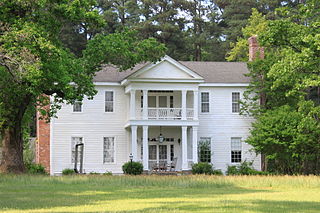
Frog Level is a historic house in rural Columbia County, Arkansas, one of a handful of surviving antebellum plantation houses in southwestern Arkansas.
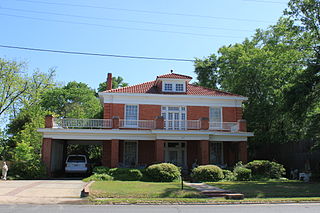
The Dr. H. A. Longino House is a historic house at 317 West Main Street in Magnolia, Arkansas. The two-story brick structure was built in 1910 for a prominent local doctor, and is one of a small number of surviving designs known to have been created by Eugene C. Seibert, a prominent local architect of the period. When built, it was one of the most imposing houses in the town. It is three bays wide, and is finished in salmon-colored brick, with a terracotta roof. It has a large front porch, which is terminated at one end by a porte-cochere. Stylistically, the house represents a transition between the revival styles of the 19th century and the Craftsman styling which became popular in the following decades.

The Wynn-Price House is a historic house on Price Drive, just outside Garland, Arkansas. The house is a rambling two-story wood-frame structure, roughly in an "E" shape, with three gable-roofed sections joined by hyphen sections. The gable ends have columned porticos, and the southern (front) facade has an elaborate two-story Greek temple front. With its oldest portion dating to 1844, it is one Arkansas' finest antebellum Greek Revival plantation houses. It was built by William Wynn, one of the region's most successful antebellum plantation owners.

The Kress Building is a historic commercial building at 210 West Main Street in Blytheville, Arkansas. It is a two-story concrete and steel structure, faced in brick and terra cotta. Built in 1938, it was one of the first buildings in the city to be built using steel framing, and is one of its finest Art Deco structures. The first floor areas are faced in terra cotta, while the second floor is predominantly cream-colored brick. Windows on the second floor are surrounded by ivory terra cotta incised with fluting and shell patterns.

The Baynham House is a historic house on Stephens Street in Success, Arkansas. It is a two-story wood-frame structure with a hip-and-gable roof, and a porch extending across the width of the front. It was built in 1911 by J. W. Baynham, a local lumber merchant, and is one of the few buildings in the community to survive from its heyday as a lumber town in the early 20th century.

The Methodist Manse is a historic house at Spring and Main Streets in Canehill, Arkansas. Built in 1834, this single-story brick structure served as the town's first Methodist church building, and was converted to its minister's house when the new wood-frame church was built in the 1850s. It is one of the community's most significant pre-Civil War buildings.
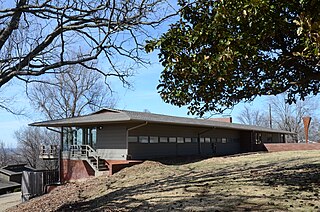
The Willis Noll House is a historic house at 531 North Sequoyah Drive in Fayetteville, Arkansas. Located on a steeply-sloping lot, it presents a single-story to the front and two to the rear. Its foundation, chimney, and part of its walls are red brick, while the rest is finished in vertical siding. The house is a long narrow rectangle capped by a shallow-pitch gable-on-hip roof. Built in 1950, it is one of five houses in Arkansas designed by native son Edward Durell Stone and the only one in his home town. The house shows the influence of Frank Lloyd Wright on Stone's work, with the open floor plan, expansive windows, and the use of natural materials.
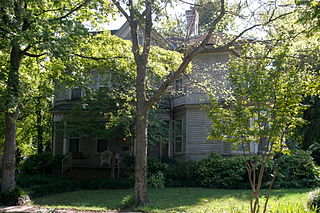
The Empie-Van Dyke House is a historic house at 403 Laurel Street in Newport, Arkansas. It is a two-story wood-frame structure, with the asymmetrical massing typical of the Queen Anne style. It has two projecting sections, one at a corner that is topped by a pyramidal tower. Built in 1891, it was one of the first Queen Anne houses built in the city, and is one of its few older homes to survive with little alteration. It was built by William B. Empie, owner of local lumber-related businesses, and survived the town's great 1927 flood.

The William Black Family House is a historic house at 311 West Ash Street in Brinkley, Arkansas. Built in 1895, this two-story wood-frame house is one of the finest examples of Queen Anne architecture in eastern Arkansas. It has asymmetrical massing, and numerous projections, towers, and porches characteristic of the style. Its siding includes different shaped shingles and clapboarding, and decorative vergeboard in some of its gables. The front porch has turned posts and balustrade, and a delicate spindlework arch in one of its bays. It was built for the widow of William Black, a prominent local businessman, politician, and veteran of the American Civil War.

The Churchill-Hilger House is a historic house at Main and Searcy Street in Pangburn, Arkansas. It is a single-story wood-frame structure, basically vernacular in appearance with some Craftsman detailing. It has a hip roof from which hip-roof dormers project, and a recessed L-shaped porch that wraps around the northern (front) and western facades. The house was built in 1914 for Harry Churchill, one of the leading businessmen responsible for Pangburn's economic success in the early 20th century. Churchill arrived in Pangburn in 1899, and built up a lucrative business manufacturing railroad ties, and successfully lobbied for the construction of the railroad through the town. At the time of the house's construction, it was considered somewhat lavish.

The Hoag House is a historic house in Judsonia, Arkansas. It is located on a wooded lot northeast of the junction of Arkansas Highways 157 and 367 in the northeastern part of the town. It is a rambling two-story wood-frame structure, with central section oriented north–south, and projecting gabled sections on the east and west sides. A two-story turret stands at the northeast junction of the main and eastern sections, topped by a pyramidal roof with gable dormers. A single-story porch with Victorian decoration wraps around the outside of the turret, joining the northern and eastern sections. Built about 1900, the house is locally distinctive for its central two-story box structure, and its Folk Victorian styling.
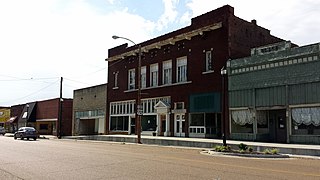
The Monroe County Bank Building is a historic commercial building at 225-227 West Cypress Street in Brinkley, Arkansas. It is a two-story brick building, with brick and stone trim elements. It houses three storefronts on the ground floor, with professional offices and other spaces on the upper floor. It was built about 1889, and its facade was redone in 1909 after suffering extensive damage caused by a tornado. The Monroe County Bank, for whom it was built, was the town's first major bank, and occupied the building until the 1930s. Its upper level also housed the town's largest performance venue of the time.
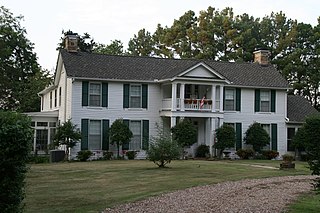
The Moose House is a historic house at 711 Green Street in Morrilton, Arkansas. It is a 2½-story wood-frame structure with a gabled roof and weatherboard siding. A two-story gabled porch projects from the center bay, supported by paired square columns. The house was built around 1832 in Lewisburg on the Arkansas river and known as the Markham Tavern. It was moved to its current location after the Civil War by James Miles Moose, one of the two founders of Morrilton. The area where this house was built was farmland until the 1880s, when the railroad arrived in the area, prompting the two men to lobby for a railroad station, around which the town grew.




















